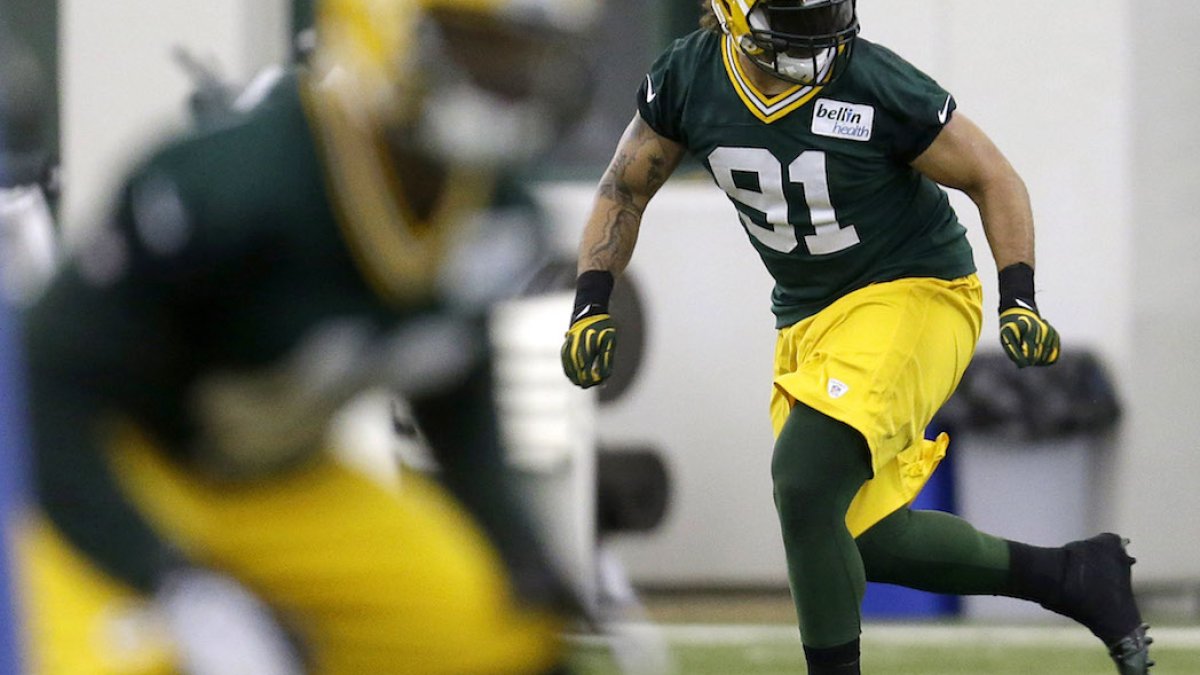On Day 2 of the PFF training camp tour, Director of Analytics Nathan Jahnke traveled to De Pere, Wis., to take in Green Bay Packers’ camp.
DE PERE, Wis. – In just over a week, the NFL preseason will begin with the Green Bay Packers facing the Indianapolis Colts in the annual Hall of Fame Game. On Wednesday morning, the Packers held an outdoor practice despite the rain. While a number of starters were held out of practice with varying injuries, Green Bay gave a pretty clear picture of how the depth chart is currently shaking out.
Clay Matthews returns to OLB as part of depth chart shakeup
Shortly after the 2015 season, it was announced that the Packers intended to move Matthews back to outside linebacker. Throughout practice, Matthews lined up almost exclusively at right outside linebacker, with the only exceptions being when he moved elsewhere to pass-rush from a different location. Including the playoffs, Matthews had 60 pressures last season, the most he has recorded since 2011. That number should only increase with more pass-rushing opportunities—assuming he can stay healthy.
It was surprising to see that, whenever Matthews was in for 11-on-11 drills at right outside linebacker, 2012 first-round pick Nick Perry would line up at left outside linebacker. In 2015, Perry was a rotational player in the base and nickel defense, and very rarely played in Green Bay’s dime defense. Last year, Perry was the Packers' best outside linebacker against the run. His 7.1 run-stop percentage was tied for 10th-best among outside linebackers. It wouldn’t be surprising if Perry ends up as a starter due to his good play against the run, which could also lead to additional pass-rushing opportunities.
The move also suggests less playing time for Julius Peppers. Peppers saw a slight decrease in snaps throughout last season, thanks to more rotation in the base and nickel defense. The Packers didn’t use their dime defense much in 11-on-11 drills, but when they did, it was the first-team defense, and Peppers was still in. The last surprise was seeing Jay Elliott playing with Peppers in the second team, with Datone Jones playing outside linebacker with the third team. Elliott was a top-eight edge defender in each of the last two preseasons, and played well on small sample sizes during the regular season. Jones started the transition to outside linebacker late last season. Unless he excels this month, he might only see playing time in the dime defense in 2016.
Jeff Janis continues to get his shot to play
When August rolls around, a player that becomes a fan favorite in Green Bay is typically whomever the fifth wide receiver on the depth chart is. Right now—assuming everyone will be healthy by Week 1—that would be Jeff Janis. After getting selected in the seventh round of the 2014 draft, Janis barely saw playing time on offense as a rookie. It took injuries to Jordy Nelson and Davante Adams for him to see playing time early in the 2015 season. Later in the season, the Packers had even more injuries, which led to a breakout game against the Cardinals in the playoffs. On just 32 pass routes, Janis caught seven of 11 passes thrown his way for 145 yards and two touchdowns.
With both Nelson and Ty Montgomery held out of practice, Randall Cobb, Adams, and Janis saw playing time in the 11-on-11 drills. The third wide receiver spot behind Nelson and Cobb seems to be wide open. Adams held the job last year, but his 1.04 yards-per-route-run mark was eighth-worst for wide receivers in 2015. With Jordy Nelson out, now is Janis' best opportunity to prove he that should be a starter this year.
Who replaces Casey Hayward in the slot?
Rarely does a team have a rookie cornerback perform well in their first pro season—the Packers were lucky enough to have two in 2015. This helped make Casey Hayward expendable. After several years as the Packers slot cornerback, Hayward left for San Diego in free agency. Going into training camp, it was expected that Damarious Randall and Sam Shields would play outside, while Quinten Rollins would take over in the slot. 19 percent of Rollins' snaps last year came from the slot, compared to less than 5 percent for both Randall and Shields.
In practice, Randall and Rollins were splitting time with one player at left cornerback and the other in the slot. This shouldn’t be all that surprising, based on the success Randall had playing in the slot in college. In 2014, when Randall lined up in the slot and was targeted, opposing quarterbacks had an NFL passer rating of 52.1, ninth-lowest for defensive backs in the slot. Giving both players experience at both positions should give the Packers flexibility going forward.
Other notes:
– The Packers' first three draft picks—DT Kenny Clark (UCLA), OT Jason Spriggs (Indiana), and OLB Kyler Fackrell (Utah State)—will need to earn their playing time. None of them saw snaps with the starters, and Fackrell is currently buried behind six other players on the depth chart.
– Fourth-round pick Blake Martinez saw plenty of playing time with the starters. While Sam Barrington wasn’t practicing, Martinez appeared to already be ahead of Joe Thomas and Carl Bradford. Martinez will be given a chance to earn playing time in the base and nickel defense, as well as potentially be the linebacker in the dime defense.
– With Corey Linsley on the PUP list, J.C. Tretter took the first-team snaps at center. Tretter saw snaps at four of the five offensive-line positions last year, as well as at tight end. He graded above-average over the course of the season, especially when lined up at center. If a starter is hurt during the season, Tretter could certainly be the replacement; a solid 2016 performance could land him a decent free-agent deal next offseason.


 © 2024 PFF - all rights reserved.
© 2024 PFF - all rights reserved.